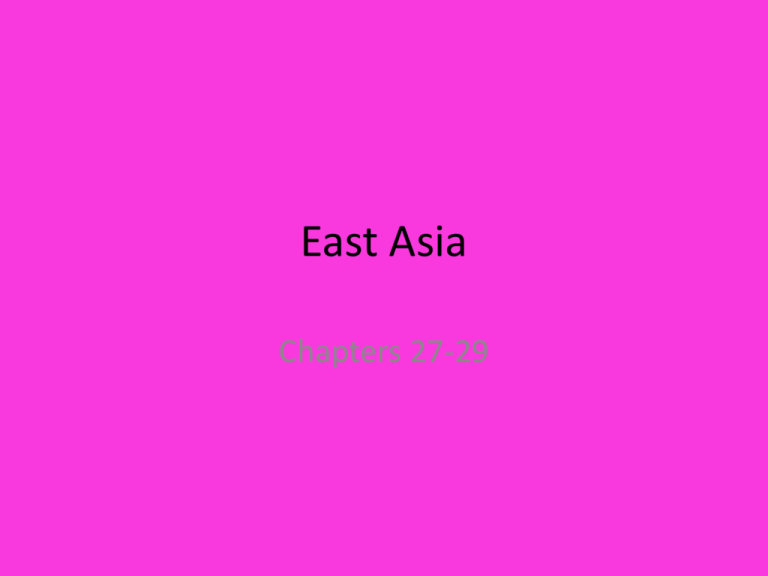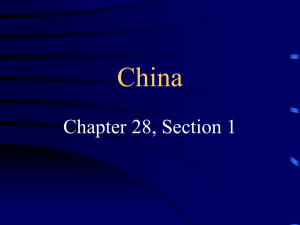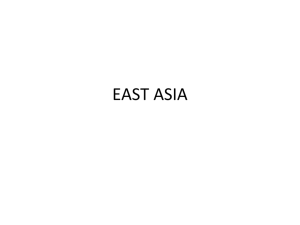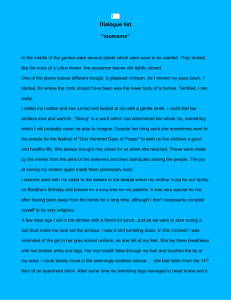East Asia
advertisement

East Asia Chapters 27-29 Landforms • High mountains in this region limited contact between people living in Asia – Kunlun Mountains- located west of China – Qinling Shandi Mountains- divide north and south China. • Although very mountainous, some low lying plains exist and are sparsely populated. – Plateau of Tibet, Tarim Pendi Basin. Landforms • Deserts – Largest desert in the world, the Gobi is larger than Texas and California combined • Peninsulas – The eastern coast of China • Many ports due to large coastline • Korean Peninsula – The Islands of East Asia • Formed by continental shelf • Hong Kong is part of this island chain Rivers • Three great rivers in China – Huang He (Yellow River): causes terrible flooding – Chang Jiang (Yangtze River): Longest river in Asia, major trade route – Xi Jiang (West River): forms large estuary- where a river meets ocean tides – Yalu Jiang: forms border between China and Korea and was the starting point of the Korean War Resources • Natural and mineral resources are unevenly distributed throughout East Asia. – Example: China, North Korea, and Mongolia have plentiful resources and Japan, South Korea, and Taiwan do not – The latter three are great world powers nonetheless • Land and Forests – Due to mountainous areas, agriculture is limited – Vast supplies of forests to all countries and areas • Mineral and Energy Resources – China has large supply of petroleum, coal, and natural gas – Japan trades for what it needs Climate • Subarctic- small sliver in northern Mongolia that has extremely cold climate • Highland- Western China, the higher the altitude and latitude, the colder it gets, sparsely populated, vast tundra • Humid Continental- NE China, North Korea, and northern South Korea, temperate grasslands • Humid Subtropical- SE China, Southern South Korea, and Taiwan, forests of mixed variety and sandy soil Human-Environment Interaction • Three Gorges Dam – – – – Built on the Chang Jiang Controls flooding on the 3rd largest river in the world Also creates energy World’s biggest dam • Positive Effects: – Irrigates ½ of Chinese crops – Allows ships to reach the Chinese interior – Provides power • Negative Effects: – Between 1 and 2 million people have had to relocate due to water levels – Construction costs Human-Environment Interaction • Japanese Overcrowding – 60% of Japanese live on 3% of the land – Pollution • Mercury poisoning causes disease – Adapting to limited space • Shown great ingenuity in adapting to space • Landfills: soil waste disposal method in which trash is buried between layers of dirt to fill low lying ground – Creating more land in large cities China • China has been settled for over 4,000 years • Lived off dynasty rule: – A series of rulers from the same family • Shang Dynasty- 1st Chinese dynasty • Zhou Dynasty- ruled Northern China • Qin Dynasty- Gave China its name and established a strong central government • Han Dynasty- moved China into central Asia • Qing- People of Manchuria China • China remained isolated and separated from the world for centuries until 13th century – Trade allowed other countries into China and carved up the realm due to China’s lack of military – Spheres of Influence: Controlled by Britain, France, Germany, Russia, and Japan – Boxer Rebellion in 1900: Chinese tried to overthrow Western ideas and influence China • Chinese Revolution – Qing Dynasty tried to reform government after the Boxer Rebellion • It was too late – 1912, Sun Yat-sen lead China into a republic – 1925, General Chiang Kai-shek took over the Nationalist party for Sun Yat-sen (died) and increased communism – 1949, Mao Zedong takes over and communism won over in China – 1976, Deng Xiaoping modernizes China’s political machine China • The Economies of China – Rural Economy: • China is a largely rural society • Self-Sufficient in farming – Industrial Economy: • Manufacture coal, iron ore, and oil • Shanghai is the manufacturing center of China China • Religions of China – Confucianism: • Started by Confucius around 551 BC • People should know their past ancestors and honor their elders • Education is important – Taoism • From the book Tao-te-Ching • Importance of restoring harmony with self and nature • Government should leave people alone – Buddhism • Came to China from India • Rebirth cycle Mongolia and Taiwan • The Mongols were nomadic herders for thousands of years • Genghis Khan expanded Mongol’s area – Fought China and lost in the 14th Century – Ruled by China until 1911 – Mongolia lived under Communist rule for about 72 years – Now working to modernization and freeenterprise Mongolia and Taiwan • Taiwan is an island that was settled by Malay and Polynesian peoples • The Han dynasty took over the island • The island was won in a war between China and Japan – Japan kept control of the island until the end of WWII – After WWII, became Communist with Mao Zedong • China today does not recognize Taiwan as a separate nation – Still considers it a province of China Mongolia and Taiwan • Mongolia still has nomads and farming is essential • Taiwan is still and island and trade is still essential • Mongolia working to update infrastructure and herding methods to open up trade with the rest of the world • Taiwan has one of the world’s most successful economies – Despite resources – Economic Tiger: a nation that has a rapid economic growth due to cheap labor and high technology – Part of the Pacific Rim: Countries that surround the Pacific Ocean The Koreas • A Divided Peninsula – Ancestors came from Manchuria and northern China – Invaded by Japan and China due to location • Three Kingdoms – Koreans gradually won back independence – Koguryo, Paekche, Silla kingdoms – Silla kingdom eventually conquered the other two • Yi S’ong-gye became ruler in 1392 and ruled his dynasty ruled for centuries – Japan invaded before WWII and ruled until after the war. The Koreas • Korea split after WWII – North controlled by Soviet Union – South supported by United States • 1950, Korean War broke out – Communists (North and China) vs. Democratic (US and South Korea) – War ended in stalemate – Sides remained hostile until 2000, tried to start unification process but North Korea is still ruled by crazy dictator The Koreas • Korea has adapted many ideas from China – Confucianism – Buddhism – Communism • Before the Korean War, economy was very agricultural based – Experts say a unified Korean peninsula would form an economic powerhouse • Example: Resources from North Korea and trade in South Korea – South Korea is a Tiger Economy Japan • Made into four islands – Honshu(main), Hokkaido, Shikoku, Kyushu • Samurai and Shogun – Until 300 AD, Japan was separate clans that farmed and traded – Yamato clan became ruling clan • Called themselves the emperors of Japan and claimed to be descendants of the sun goddess – From 794-1185, Japan had a strong central government • Landowners and clan chiefs tried to grab land and power of their area – Samurai- professional soldier (“one who guards”) Japan • Samurai and Shoguns – Shogun- was the general of the emperor’s army with powers of a military dictator – All officials, judges, and armies were under his power – Appointed provincial governors called Daimyo • Their job was to keep order in their area – Shogun ruled for 700 years until… • Mongols tried to invade (a bunch of times) • Portuguese traders brought religion and guns (1500s) • Matthew Perry arrived in the name of the US (1853) Japan • Emerging World Power – Japan expanded empire from 19th-20th century – Fought with the Axis during WWII • Lost war and the US took over the government and introduced reforms to political and economic systems – Japan ranks only behind the US and China in economy – Most industry and manufacturing lies 100 miles along the main island of Honshu • Manufacturing and trade are the heart of their economy – Very strong alliances between businesses and the government Japan • Culture – Eastern Influence: • Language, art, music, religion, and government is borrowed from China – Western Influence: • Sports, fashion, architecture • Education – Highly structured • • • • 6 days a week Shorter summer vacations Free school from k-8 High schools are chosen (called juku) and are competitive East Asia Issues • Ring of Fire – A chain of volcanoes that line the Pacific Rim – Cause a shifting of tectonic plates • Create earthquakes and tsunamis – Many older buildings are not able to sustain this stress – Created strict building codes • How does East Asia continue to see an economic and population boom with these problems? • What happens when they cannot prepare for the worst? East Asia Issues • Trade and Prosperity – Open to the world since 1800s – Global economies- nations become dependent on each other for goods and services – Powerful economies • Jakota Triangle (Japan, Korea, and Taiwan) – World Recession hurt the economies of East Asia • May have caused global recession • Sweatshops are protested around the world • What is the best practice by countries of East Asia toward their global economy? • How does population and the United States help or hurt these economies?








